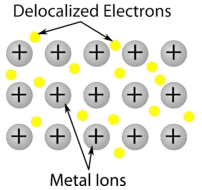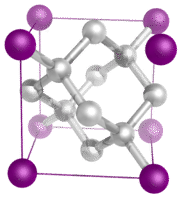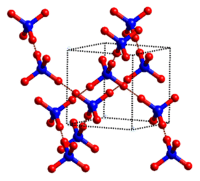13.15: Classes of Crystalline Solids
- Page ID
- 53814

What are common things that we connect to wires?
We often take a lot of things for granted. We just assume that we will get electric power when we connect a plug to an electrical outlet. The wire that comprises that outlet is almost always copper, a material that conducts electricity well. The unique properties of the solid copper allow electrons to flow freely through the wire and into whatever device we connect it to. Then we can enjoy music, television, work on the computer, or whatever other activity we want to undertake.
Classes of Crystalline Solids
Crystalline substances can be described by the types of particles in them, and the types of chemical bonding that take place between the particles. There are four types of crystals: (1) ionic, (2) metallic, (3) covalent network, and (4) molecular. Properties and examples of each type are described in the table below.
| Type of Crystalline Solid | Examples (formulas) | Melting Point \(\left( ^\text{o} \text{C} \right)\) | Normal Boiling Point \(\left( ^\text{o} \text{C} \right)\) |
|---|---|---|---|
| Ionic | \(\ce{NaCl}\) | 801 | 1413 |
| \(\ce{CaF_2}\) | 1418 | 1533 | |
| Metallic | \(\ce{Hg}\) | -39 | 630 |
| \(\ce{Na}\) | 371 | 883 | |
| \(\ce{Au}\) | 1064 | 2856 | |
| \(\ce{W}\) | 3410 | 5660 | |
| Covalent Network | \(\ce{B}\) | 2076 | 3927 |
| \(\ce{C}\) (diamond) | 3500 | 3930 | |
| \(\ce{SiO_2}\) | 1600 | 2230 | |
| Molecular | \(\ce{H_2}\) | -259 | -253 |
| \(\ce{I_2}\) | 114 | 184 | |
| \(\ce{NH_3}\) | -78 | -33 | |
| \(\ce{H_2O}\) | 0 | 100 |
1. Ionic crystals: The ionic crystal structure consists of alternating positively-charged cations and negatively-charged anions (see figure below). The ions may either be monatomic or polyatomic. Generally, ionic crystals form from a combination of Group 1 or 2 metals, and Group 16 or 17 nonmetals or nonmetallic polyatomic ions. Ionic crystals are hard, brittle, and have high melting points. Ionic compounds do not conduct electricity as solids, but do conduct when molten or in aqueous solution.

2. Metallic crystal: Metallic crystals consist of metal cations surrounded by a "sea" of mobile valence electrons (see figure below). These electrons (also referred to as delocalized electrons) do not belong to any one atom, but are capable of moving through the entire crystal. As a result, metals are good conductors of electricity. As seen in the table above, the melting points of metallic crystals span a wide range.

3. Covalent network crystals: A covalent network crystal consists of atoms at the lattice points of the crystal, with each atom covalently bonded to its nearest neighbor atoms (see figure below). The covalently bonded network is three-dimensional and contains a very large number of atoms. Network solids include diamond, quartz, many metalloids, and oxides of transition metals and metalloids. Network solids are hard and brittle, with extremely high melting and boiling points. Being composed of atoms rather than ions, they do not conduct electricity in any state.

4. Molecular crystals: Molecular crystals typically consist of molecules at the lattice points of the crystal, held together by relatively weak intermolecular forces (see figure below). The intermolecular forces may be dispersion forces in the case of nonpolar crystals, or dipole-dipole forces in the case of polar crystals. Some molecular crystals, such as ice, have molecules held together by hydrogen bonds. When one of the noble gases is cooled and solidified, the lattice points are individual atoms rather than molecules. In all cases, the intermolecular forces holding the particles together are far weaker than either ionic or covalent bonds. As a result, the melting and boiling points of molecular crystals are much lower. Lacking ions or free electrons, molecular crystals are poor electrical conductors.

Summary
- Ionic crystals are composed of alternating positive and negative ions.
- Metallic crystals consist of metal cations surrounded by a "sea" of mobile valence electrons.
- Covalent crystals are composed of atoms which are covalently bonded to one another.
- Molecular crystals are held together by weak intermolecular forces.
Review
- What is an ionic crystal?
- What type of crystal is a diamond?
- What forces hold molecular crystals together?
- Which type of crystal is a good conductor of electricity?

